The banjo and fiddle are two of the many instruments that were created by Black people. In fact, they are the greatest instruments derived from the creativity of Black people considering the impact they have had on the history of music. Back in they day, they were known to have a huge influence in folk music. As time passed, white people “appropriated” the banjo and fiddle. What people do not know, is that these instruments would evolve to become the foundation of country music.

Over the years, historians have developed the idea the African American slaves were introduced to the fiddle by Europeans, however, several slaves transported in the transatlantic slave trade were from areas in which fiddling was well-known. Many are uninformed of the importance of fiddling in parts of West Africa. The fiddle is significant to various musical traditions in the culture of some tribes in West Africa. If slaves in the United States were gifted with the ability to fiddle, the were highly prized. Europeans valued it so much that they used it to primarily increase the economic productivity of slaves and for their own entertainment purposes such as dances. White people would create posters around the city that would streets the importance of finding a runaway slave who could play the fiddle.




Now you are informed of the main two instruments that were created by Africans to later establish what is now known as country music. When you listen to country music, you can hear the blackness embraced in it from the timbre, instruments, and language. Not to degrade white country artists, but there would be no Garth Brooks, Reba McEntire, Dolly Parton, or Billy Ray Cyrus, without the beautiful creativity and imagination of Black people.
Watch Famous Black Country Artists Here!
https://www.youtube.com/watch?v=pqlD-eZm1ck

Login to your account